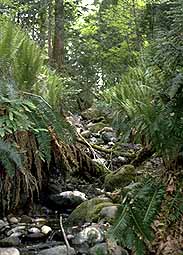
High Elevation



Valley
Individual streams are part of a larger network called a watershed.
A watershed begins with small trickles of water. Many of these small trickles gather and form consecutively larger stream types which grow: from brooks to creeks to rivers. As the volume of water increases in the stream channel, the stream channel has a greater cross-sectional area.
 High Elevation |  |  |  Valley |
There is a pattern of progressive physical change that occurs from higher in a watershed to the base. The changes include :
 These changes occur due to geology. In the higher elevations, streams are narrow, soils are thin and streambeds are mostly rock--not much sediment. As a stream flows and grows, it picks up sediment and flattens out.
These changes occur due to geology. In the higher elevations, streams are narrow, soils are thin and streambeds are mostly rock--not much sediment. As a stream flows and grows, it picks up sediment and flattens out.
Living is not easy for aquatic creatures at either end of the continuum-- in the headwaters or at the lower reaches of the river. The environment is harsh: less space, less food, greater extremes of temperature. It's in the middle of the continuum where they find more opportunities to make a suitable living.
Stream-dwelling communities, such as fish and aquatic invertebrates, respond to the different changes. The "River Continuum Concept" is trying to help describe the physical processes (geology, climate) outside of a river that effect the biological processes (vegetation) along a river, which in turn effect the physical and biological processes within a river (temperature, nutrients). In other words, the pattern of physical change in a watershed and the biotic adjustments are called the "River Continuum Concept".